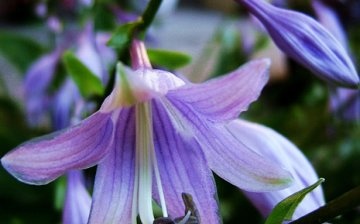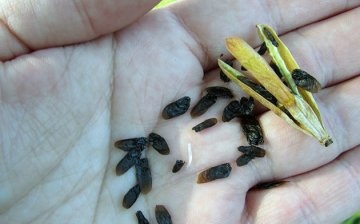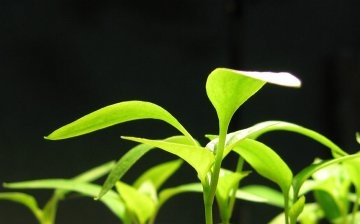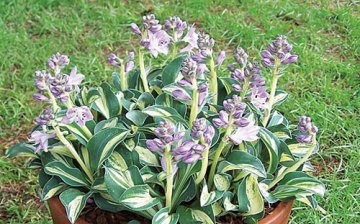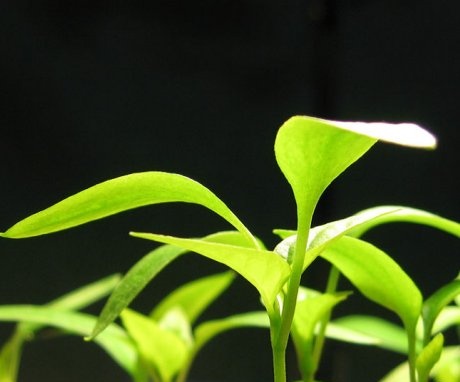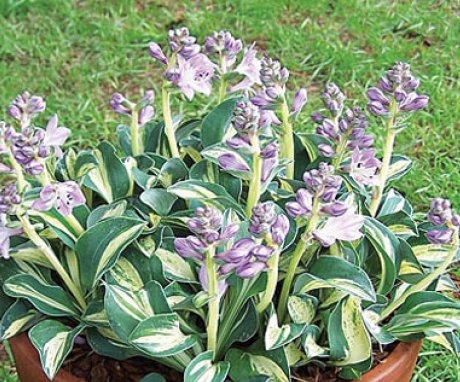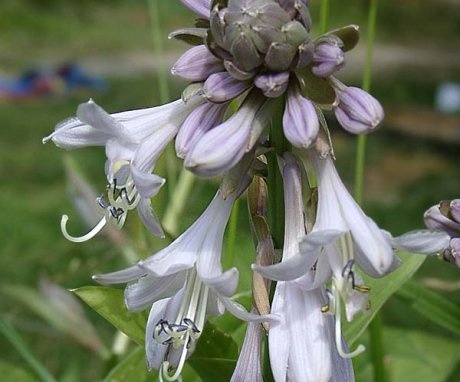Hosta from seeds: how to grow a beautiful garden
Gardeners dubbed the mysterious hosta "Queen of the Shadow" because she loves to hide from the bright sun. Framing a plot with such plants is not a cheap pleasure, because the cost of seedlings is quite high. The way out of the situation is to independently propagate the host with seeds.
Content:
- Hosta is a fashionable element of garden decor
- Seed reproduction hosts: preparation
- Germination of seedlings of hosts from seeds
- Planting a flower in the garden: when, how and where?
- Care of young plants
Hosta is a fashionable element of garden decor
Hosta is a unique flower, one of the most popular among landscape designers. The unrelenting interest in the plant over the years is understandable. It is difficult to find a flower that can replace the hostu in terms of decorating shady areas of backyards. The culture comes from the East. Naturally occurs in Japan, China and Korea. It has been familiar to European gardeners since the 19th century.
To date, more than 4000 host species are listed in the International Register.
This is by no means the limit. Through the efforts of breeders, new names are added to the list every year. Hosta belongs to the Liliaceae family. All plant species are herbaceous, stemless perennials. The height of the flowers ranges from 5 cm to 1m 20 cm. Numerous cord-like roots grow in depth up to 20-30 cm. The densely intertwined branches are a reliable support for the hosts.
The main decoration of culture is chic leaf hat... Heart-shaped, on a long petiole, they differ in shape and color. Veins stand out on the blue, yellow, green fringed foliage.
Quite late (at the very end of summer), the hosta adds purple, pink, lilac and white colors to the garden. The graceful brush consists of funnel-shaped or funnel-bell-shaped flowers. The triangular leathery capsule contains many flat seeds. Their shade is black or black-brown. The planting material retains its properties throughout the year.
Connoisseurs fell in love with the culture for its undoubted advantages: cold resistance, high decorative effect, the ability to grow in the shade. The adults of the tall species are similar to the inhabitants of the tropics.
For the hosta to show itself in all its glory, you will have to wait 4-5 years.
After another 4-5 years, the plant will not lose its merits, developing in one place for up to 25 years. With age, the culture will become more colorful: it will throw out large leaves, show the shape and shade characteristic of the species. The popularity of the eastern modest woman is due to her decorativeness, which has remained unchanged for decades.
Seed reproduction hosts: preparation
Almost all types of hosts can be grown from seeds. The plant matures 6-8 weeks after pollination. This happens in late summer or early autumn. You must not miss the moment when the seed boxes turn brown and open. This is a signal that it is time to stock up on planting material.
Hosts will come up amicably with proper storage of raw materials. The collected seeds are scrupulously dried at a high temperature (30-350 C) for the most complete evaporation of moisture. Before sowing, they are kept at 2-40 C.
Breeding secrets:
- Reproduction of hosts in this way begins with sterilizing the soil and planting containers.Destruction of fungi and microorganisms is the key to the health of future seedlings.
- The soil for the culture is watered with a concentrated solution of potassium permanganate and incubated for 30 minutes in a water bath. Medical alcohol is used to disinfect containers.
- You can purchase the substrate at a specialty store. The necessary components in its composition are perlite, peat, vermiculite.
- Seed germination depends on its processing. Raw materials are soaked in growth stimulants (Epin, Zircon, Kornevin).
- Some professionals recommend do stratification. Germination energy will increase significantly if the seeds are kept in the cold for 2-2.5 months.
- For the successful cultivation of a crop, it is important to prepare seeds on time, store them correctly, prepare the soil and containers for sowing.
Germination of seedlings of hosts from seeds
They start working in April or May. Sowing actions:
- Place a drain on the bottom of the container.
- Pour in the substrate.
- Scatter seeds over the surface (1 piece per 1 cm2).
- Above - a layer of soil (thickness from 5 to 7 mm).
- Slightly compact the substrate.
- Moisten the soil well.
- Put on newspaper to absorb excess moisture.
- Cover with plastic or glass.
The containers are kept in a room where the soil temperature does not drop below 180 C and does not warm up above 250 C. In such conditions, the seedlings will appear in 2-3 weeks. Hosta germination will be slowed down by excessive heat or cold. Seedlings will feel bad in a container that is too deep or too low. Weakly branched roots of young host will fit in dishes 8-10 cm high. The ideal container is plastic with holes in the bottom.
Seedlings should be protected from direct sunlight. It is important to water it on time, but in moderation, and periodically remove condensation. It is recommended to lift the airing film every day.
The appearance of the first pair of leaves is a signal that it is time to dive the plants into separate flowerpots. Flowers are placed in soil, on a block covered with sand.
For sufficient moisture of the dived seedlings, the bottom irrigation method is used. The pot with the host is placed in a deep container of water. It is kept this way until the topsoil is saturated with moisture. Young hosts need tempering. They start by removing glass or polyethylene for several hours. After 7 days, the coating is finally removed. If the air outside warms up to 18-190C, the flowers are briefly taken out of the room.
The seed host grows very slowly. The first summer season will be marked by the appearance of three small leaves. The bush will become full only after 3-5 years. Often such a plant loses its varietal characteristics. Cultivation of hosts from seeds is a simple but long process that will take more than one year.
Planting a flower in the garden: when, how and where?
It is important to choose the right permanent location for the function. Ideal conditions are partial shade, no downward wind. Plant varieties relate to sunlight in different ways: it all depends on the pattern on the leaves, their color. Bright colors, a large number of white and yellow fragments indicate that this species loves light.
Variegated plants will do well in an area illuminated only in the morning and evening.
At noon, the flower prefers to rest in the shade. It can be hidden from direct rays by planting a taller plant next to it. Blue hosts cannot stand the abundance of the sun. During the day, they like to hide in the shadows, only showing up for 2 hours. The minimum amount of light inhibits the development of the bush, which pays off with the formation of large foliage. Such a host stretches upward.
The culture needs moist, humus-rich, neutral or slightly acidic, drained soil... On sand, heavy loam, the flower will not be comfortable.
It is recommended to prepare a site in advance for planting young bushes. In autumn, organic fertilizers are distributed over the ground (layer thickness - 10 cm). Next, the soil must be dug to the depth of the shovel bayonet. In the spring the soil is ready to "accept" the host.
Planting seedlings:
- Prepare the wells. For small plants, a distance of 30-60 cm is adhered to, for giants - 80-100 cm.
- Water the seedlings abundantly a few hours before starting work.
- Place the bushes in the pits a couple of centimeters below ground level, without shaking off the substrate from the rhizome.
- Spread the roots carefully.
- Cover with soil, crush.
- Water abundantly.
- The area around the plant should be mulched with chopped bark.
Planting a host in the second half of summer will allow them to gain strength and successfully endure the winter. The types of funky relate differently to the intensity of sunlight, but they are planted in the ground in almost the same way.
Care of young plants
Growing hosts will appeal to those who do not like digging in the ground or who simply have no time to do it. An adult plant is striking in its unpretentiousness, but young individuals require some attention.
host move:
- Newly planted funkias should be watered regularly. Do it in the morning or evening. The darkened tips of the flower "tell" that it lacks moisture.
- It is better to refuse loosening, replacing it with peat mulching. Thus, moisture will be preserved, and the underground part of the hosta is not injured. When the plant matures, the need for weeding will disappear by itself: overgrown roots and dense foliage will not allow them to multiply.
- The flower has nothing against feeding, although it will live without them. Fertilizers (ammonium nitrate, superphosphate, potassium sulfate) are applied with the onset of spring, before and after flowering. If the hosts were planted in well-prepared soil, nutrients begin to be used after a few years.
The culture is resistant to most diseases and pests. To protect the plant, preventive measures are taken against slugs.
Hosta is a perennial for "lazy" gardeners, undemanding and colorful. There are no special tricks in the propagation of funkia from seeds. Cultivating a plant with this method is an opportunity to create unique garden decor do it yourself.
More information can be found in the video.



